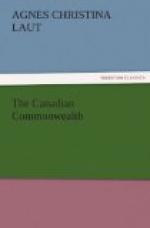Exuberant forest growth is always characterized by some fungus and dry rot. How has Canada escaped so much of this fungus excrescence of representative government? To get at the reason for this it is necessary to trace back for a little space the historic growth of Canada’s form of government. We speak of Canada’s constitution being the British North America Act. As a matter of fact, Canada’s constitution is more than an act—more than a dry and hard and inflexible formula to which growth must conform. Rather than plaster cast into which growing life must fit itself, Canada’s constitution is a living organism evolved from her own mistakes and struggles of the past and her own needs as to the present. Canada’s constitution is not some pocket formula which some doctrinaire—with apologies to France—has whipped out of his pocket to remedy all ills. Canada’s constitution is like the scientific data of empirical medicine; it is the result of centuries’ experiments, none the less scientific because unconscious.
One need not trace the growth of government to the days prior to English rule. When England took over Canada by the Treaty of Paris in 1763, the main thing to remember is that the French-Canadian was guaranteed the free exercise of his religion. This—and not innate loyalty to an alien government—was the real reason for Quebec refusing to cast in her lot with the revolting American colonies. This was the reason for Quebec remaining stanch in the War of 1812, and this is the reason for Quebec to-day standing a solid unit against annexation. We must not forget what a high emissary from Rome once jocularly said of a religious quarrel in Canada—Quebec was more Catholic than the Pope.
Following the military regime of the Conquest came the Quebec Act of 1774.—Please note, contemporaneous with the uprising of the American colonies, Canada is given her first constitution. The Governor and legislative council are to be appointed by the Crown, and full freedom of worship is guaranteed. French civil law and English criminal law are established; and the Church is confirmed in its title to ecclesiastical property—which was right when you consider that the foundations of the Church in Quebec are laid in the blood of martyrs. Just here intervenes the element which compelled the reshaping of Canada’s destiny. When the American colonies gained their independence, there came across the border to what are now New Brunswick and Nova Scotia and Ontario some forty thousand Loyalists mainly from New England and the South. These Loyalists, of course, refused to be dominated by French rule; so the Constitutional Act was passed in 1791 by the Imperial Parliament. The people of Canada were represented for the first time in an assembly elected by themselves, The Governor-General for Quebec—Lower Canada—and the Lieutenant-Governor for Ontario—Upper Canada—were both appointed by the Crown. The Executive, or Cabinet, was chosen by the Governor.




